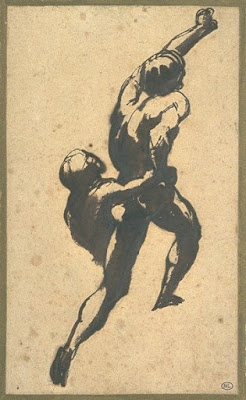 |
| Théodore Géricault Study for Horse Race ca. 1816-17 drawing Musée du Louvre |
 |
| Théodore Géricault Man subduing a Bull (study after the antique) 1817 drawing Musée du Louvre |
 |
| Théodore Géricault Stag Hunt before 1824 drawing Musée du Louvre |
 |
| Théodore Géricault Nymph and Satyr ca. 1816-17 drawing Musée du Louvre |
 |
| Théodore Géricault Satyr and Nymph ca. 1816-17 drawing Musée du Louvre |
 |
| Théodore Géricault Leda and the Swan ca. 1816-17 drawing Musée du Louvre |
 |
| Théodore Géricault Embracing Couple before 1824 drawing Musée du Louvre |
 |
| Théodore Géricault Centaur abducting Nymph 1816 drawing Musée du Louvre |
 |
| Théodore Géricault Centaur abducting Nymph 1816 drawing Musée du Louvre |
 |
| Théodore Géricault Scene of Ancient Sacrifice 1817 drawing Musée du Louvre |
 |
| Théodore Géricault Sheet of Studies after the Antique ca. 1816-17 drawing Musée du Louvre |
 |
| Théodore Géricault Sheet of Studies after the Antique ca. 1816-17 drawing Musée du Louvre |
 |
| Théodore Géricault Sheet of Studies after the Antique ca. 1816-17 drawing Musée du Louvre |
 |
| Théodore Géricault Study for The Raft of the Medusa 1818-19 drawing Musée du Louvre |
 |
| Théodore Géricault Study for The Raft of the Medusa 1818-19 drawing Musée du Louvre |
"Théodore Géricault was born on 26 September 1791 in Rouen to parents of the property-owning middle class. The family moved to Paris in about 1796. On graduating from the Lycée Impérial in 1808, [Théodore] declared his intention to become an artist. The death of his mother the same year brought him an annuity that assured his future independence. Against his father's wish, he apprenticed himself to Carle Vernet (1758-1836), the fashionable painter of equestrian subjects, who allowed him the freedom of his studio but seems not to have given him any formal training. Feeling the need for more disciplined education, Géricault in 1810 moved to the studio of Pierre Guérin (1774-1833), a rigorous classicist and conscientious teacher, who made an effort to put him through the routines of the academic curriculum. Géricault proved to be a resistant pupil who kept up his attendance at Guérin's studio only for eleven months. Few traces remain of his student work. After taking amicable leave of Guérin, he continued his training as his own master, setting up his easel in the galleries of the Louvre, which were filled with the art loot of Napoleon's campaigns. Reacting against Guérin's classicism, he copied paintings by the dramatic colorists of the Renaissance and the baroque, particularly Titian, Rubens, Van Dyck, and Rembrandt, and intermittently continued these private studies of the masters until 1815, when the allies stripped the Louvre of Napoleon's booty."
– Lorenz Eitner, in French Painting of the Nineteenth Century. Part I: Before Impressionism (Washington, DC: National Gallery of Art, 2000)